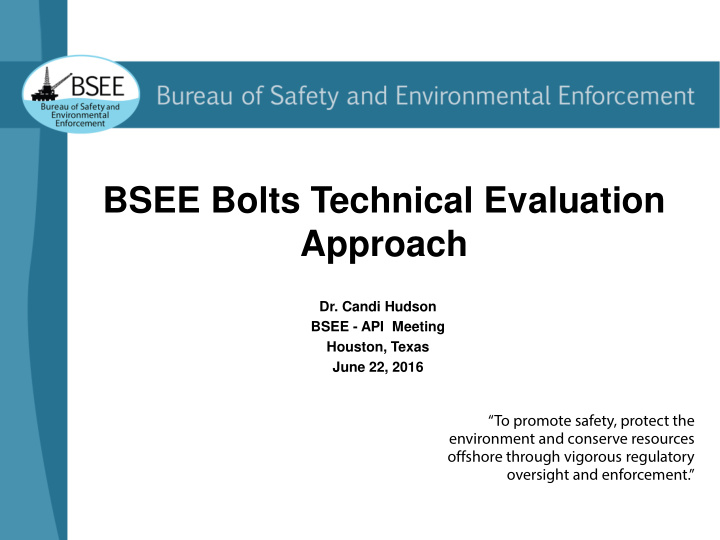



BSEE Bolts Technical Evaluation Approach Dr. Candi Hudson BSEE - API Meeting Houston, Texas June 22, 2016 “To promote safety, protect the environment and conserve resources offshore through vigorous regulatory oversight and enforcement.”
BSEE Research Activities National Academy of Science (NAS) Bolts Root Cause Analysis (RCA) Workshop BSEE Current Bolts Research & Analysis Lawrence Berkeley National Laboratory (LBNL) National Aeronautics and Space Administration QC-FIT Evaluation Future Research Project 2
NAS Bolts RCA Workshop Past NAS work for BSEE Best Available Safest Technology (BAST) (Sept. 2013) Real Time Monitoring (RTM) (April 2015) NAS Bolts RCA workshop approach is to seek expert opinion and input on bolts issue for critical components Bolts issue is of high importance for critical components such as: Blowout Preventer (BOP), Blind Shear Ram (BSR), Lower Marine Riser Package (LMRP), H4 Connector Bolts, Pipelines, etc. Safety and environment protection is very important. 3
NAS Bolts RCA Workshop NAS Bolt RCA Workshop Details: Who: Industry (Public) meeting NAS selects the Industry Bolt Subject Matter Experts NAS elects the chair person Chair to host the meeting Anyone can attend When: Late 3 rd or early 4 th Quarter 2016 Where: Washington, DC 4
NAS Bolt RCA Workshop Themes Evaluate connectors (bolts) currently in use for offshore oil and natural gas operations Selection of design factors, fatigue cyclic loading, connectors and bolt manufacture, etc. Bolt/bolt equipment Manufacture processing condition factors: raw material, forging, heat treatments, machining, coatings, etc., associated design standards Material properties requirements: mechanical properties (Yield Strength, Ultimate Tensile Strength, Hardness), coatings, corrosion performance, and cathodic protection Focus on issues that have potential industry wide (global) impact(s) 5
NAS Bolt RCA Workshop Themes Identify gaps in industry requirements, best practices, standards and regulations for offshore oil and gas. Draw upon bolt usage strategies across other industries : Onshore oil and gas, Refineries Pipeline, Aerospace, aviation, Nuclear, military, naval (submarine and ship), Automotive and jurisdictions; QA/QC concerns that may impact safety and the environment on the OCS Quality Management Systems (QMS) 6
BSEE Attempt to form a Bolt JIP BSEE met with industry and tried to develop a Bolt Joint Industry Project (JIP) through DNV in 2015 6 industry participants were initially interested. Goal was to initiate work based on BSEE GE H4 Connector QC-FIT Report’s conclusions and recommendations. Potential industry participants withdrew from the Bolt JIP BSEE initiated other measures to address Bolt concerns on its’ own 7
BSEE Current Bolts Research BSEE Initiated Research Activities Lawrence Berkeley National Laboratory (LBNL) National Aeronautics and Space Administration Results from these activities will dictate any future BSEE research projects BSEE is monitoring industry research/standards activities 8
Lawrence Berkeley National Laboratory (LBNL) Bolts Research BSEE has a five year Inter Agency Agreement (IAA) with Department of Energy (DOE) - Argonne National laboratory (ANL) BSEE thru ANL contracted LBNL to conduct research on bolts because of their materials science expertise with focus in following areas : GE QC-FIT - Quality management process was limited to prime contractor or 1 st tier level and did not address to 2 nd and 3 rd sub-tier levels Variation in standards (material properties) Inconsistency in material properties Zinc coating process and post heat treatment process relating to Hydrogen Embrittlement Global standards evaluation and gap analysis: API, ASTM, ISO, etc. LBNL to conduct mechanical testing of BSR bolt failure 9
National Aeronautics and Space Administration (NASA) BSEE has a five year agreement with NASA focusing on the following areas: Quantitative Risk Assessment Best Available Safest Technology Failure Analysis and Testing Services associated with QC FIT evaluations Bolts 10
QC – FIT: GE H4 Connector Bolts failure on LMRP Connector and Bolt Failure evaluation: Contributing factors for the cause of the bolt failure: Inconsistencies across industry standards for material properties requirements related to fasteners (bolts/connectors) Hardness, YS, UTS Industry Standards with different material property requirements Zinc Electroplating and Post Heat Treatment issues QMS audited to 1 st tier subcontracted vendors but not further down to 2 nd , 3 rd tier and lower sub-contracted vendors. 11
QC – FIT: GE H4 Connector Bolts failure on LMRP Connector and Bolt Failure evaluation: Recommendations: Consistent material property requirements for fasteners among standards Material Properties (Hardness, YS, UTS) Coatings OEM needs robust QMS oversight of 2 nd , 3 rd , and lower tier subcontracted vendors (Quality Standards) OEM to perform qualification and audit of 2 nd , 3 rd , and lower tier sub-contracted vendors 12
Bolts Summary Overview Public NAS Bolt RCA Workshop Identify gaps in industry requirements, best practices, standards and regulations LBNL to conduct Research on bolts Material properties, gap analysis, variation in standards Material testing to validate material properties for failed component NASA to conduct Failure analysis and materials testing associated with QC-FIT evaluations Results from the above activities will be shared for the benefit of the industry. Outcome of these activities may dictate future research on bolts 13
Future Bolts Research 14
BSEE Website: www.bsee.gov @BSEEgov BSEEgov Bureau of Safety and Environmental Enforcement “To promote safety, protect the environment and conserve resources offshore through vigorous regulatory oversight and enforcement.”
Recommend
More recommend